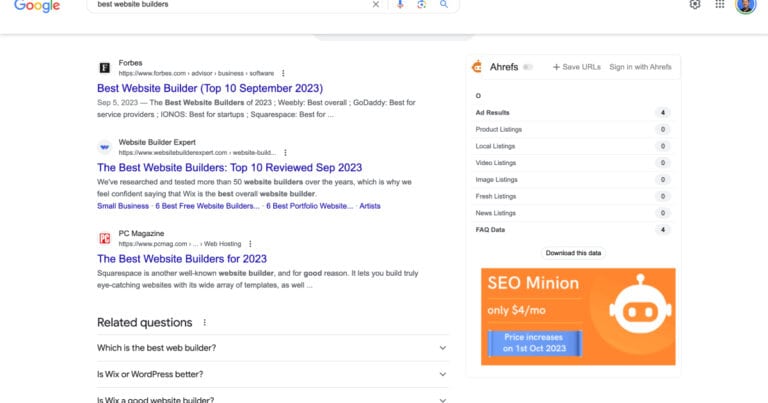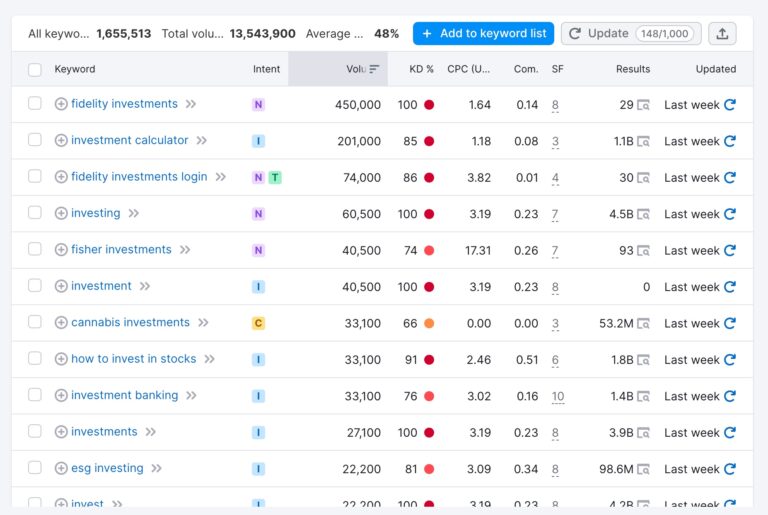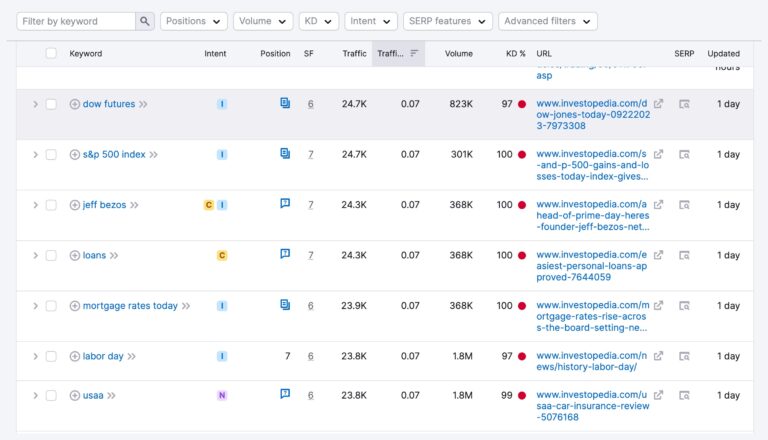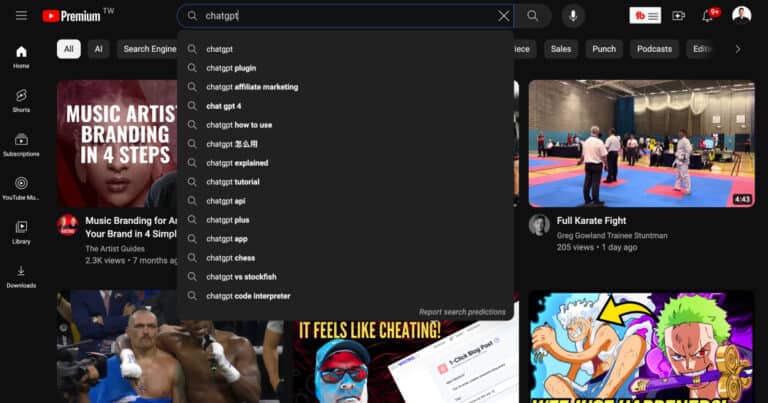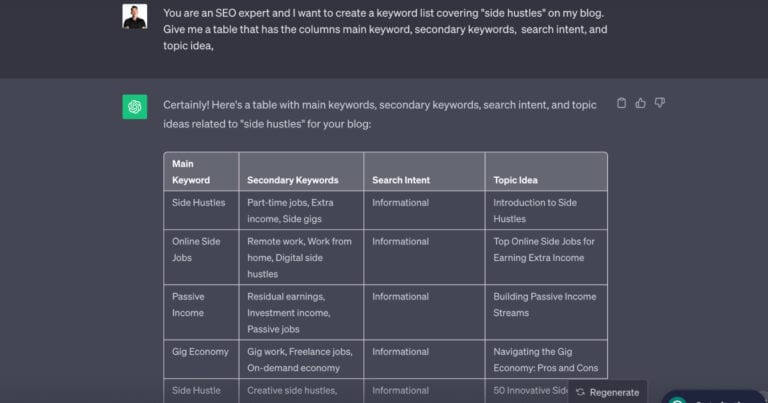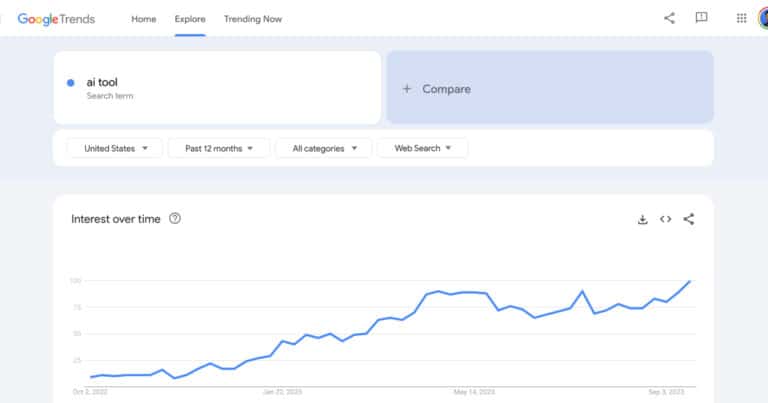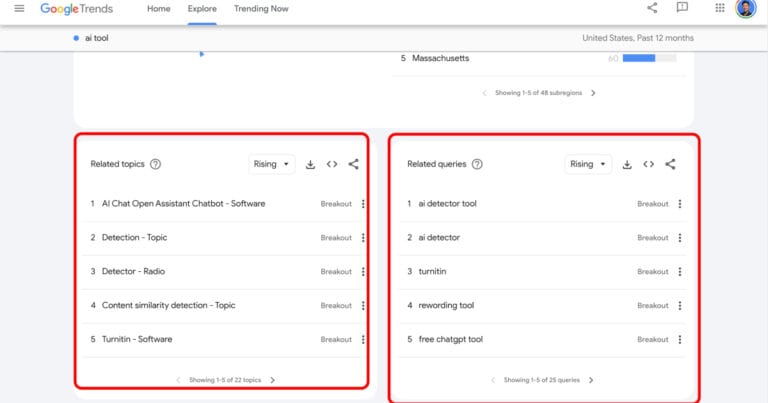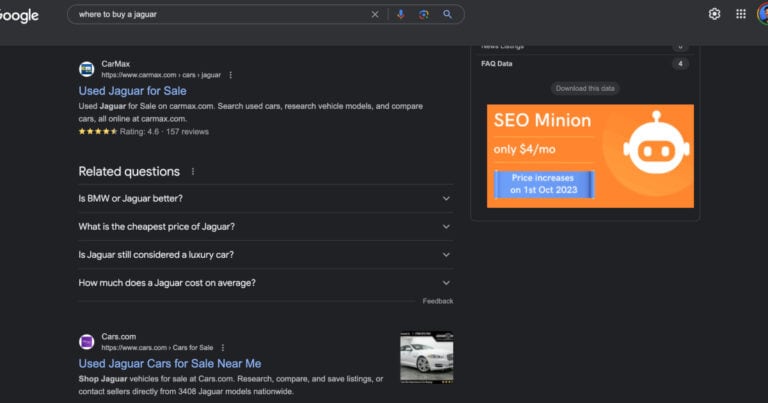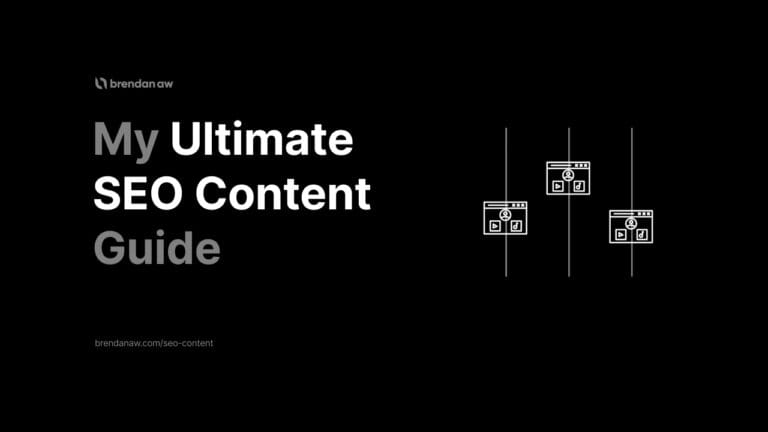If you’re a creator with a blog, you NEED keyword research for SEO (Search Engine Optimization).
Else, you’re not going to get any search traffic to your content.
It’s all about figuring out what you’re audience is searching for…
Not what YOU think they want.
This article will tell you how to do keyword research the right way.
Key Takeaways:
- Use seed keywords to generate a broad list of relevant keywords for your niche. Then, filter down based on metrics like search volume and difficulty.
- Analyze competitor keywords to discover trending topics and gaps in your niche.
- Check forums and social media for fresh, long-tail keyword ideas.
- Use multiple tools for keyword research – both free and paid options. Compare data.
- Always scan the top articles to verify search intent.
- Prioritize keywords based on search volume, difficulty, intent, and your business goals. Rank easier keywords first.
What is Keyword Research?
Keyword research is the process of finding which queries your target customers type in the search bar.
Your objective is to position your content as the best solution for these queries.
We use search engines for EVERYTHING these days:
- Comparing products
- Finding nearby services
- Getting general information
- Finding solutions to problems
The research process involves discovery and analysis…
- Discovery: Brainstorming topics related to your niche and using a keyword tool to generate high-performing keywords for your content.
- Analysis: Determining the best-performing keywords by analyzing key metrics like search volume, relevance, search intent, and competition.
Understand what your audience wants and use market intuition and data analysis for the best results.
It’s always a good idea to back your marketing strategies with hard data.
Why is Keyword Research Important?
Specific keyword choices will make or break your content.
Choose the wrong ones, and you’re throwing your precious time and effort down the drain…
But pick the right ones, and you’ve just built a rock-solid foundation for your keyword strategy.
Here’s why.
Tells You What To Create
Ever stared at a blank screen for hours, not knowing what to write about?
I have.
Creating content for your website is less about creativity and more about assembling.
Keyword research helps you identify audience interests and topic coverage.
It keeps you off the content hamster wheel.
You’ll know what they want, and all you gotta do is write.
Provides Insights on Search Intent
We’ve established that keywords tell you what your audience wants to know…
But you also want to know WHY.
This is search intent.
Search intent is why someone types a particular keyword into Google.
Let’s say you want to create content on the best website builders.
You’ll notice that the top competing results are product roundups.
This means searchers are interested in comparisons of the best options.
And that’s what you must create.
Google will always give users the best answers.
If you don’t…
Grows Long-Term Customer Base
The right keywords don’t just optimize your content…
They can also grow your business.
How?
It’s a domino effect:
- Relevant keywords + matching search intent boost your content’s search engine visibility, leading to more impressions.
- More impressions mean increased traffic and other benefits.
- More traffic and visibility increases your chances of securing high-quality backlinks, bolstering your site’s credibility.
This boosts your overall SEO performance.
And the better it is, the stronger your business grows.
How to Perform Keyword Research
Start by putting yourself in your audience’s shoes…
What information would YOU search for to solve a problem if you were them?
Now that your mindset is right, you’re ready to become a keyword ninja.
I’ll break everything down into four stages:
1. Find Keyword Ideas
This is the exploratory stage.
Using a reliable keyword tool, canvas through topics and ideas you might want to rank for.
How do you do this?
Brainstorm “Seed” Keywords
Identifying seed keywords or head terms is the starting point of your keyword research.
What are seed keywords?
These are broad terms (mostly popular keywords) that have high search volume and difficult to rank for.
I use seed keywords to generate huge lists of topics so I can create content with.
Let’s put things into action…
If you’re in the finance niche, some possible seed keywords are:
- Investing
- Credit card
- Insurance
- Loans
You don’t need to use any fancy software…
Take this as a mental exercise and put your expertise into action.
Use Keyword Research Tools
“There’s Google for everything… Do I really need to use keyword research tools?”
Of course.
A big part of keyword research is discovering topics nobody has worked on yet.
While Google is awesome…
Keyword research tools help you spot untapped keywords by offering more comprehensive and detailed data.
These include metrics like:
- Search volume: Indicates the average searches per month for a specific keyword.
- Difficulty scores: Measures how challenging it is to rank for a keyword due to competition.
- Cost-per-click: The average cost advertisers pay for each click on an ad for a specific keyword.
- Keyword variations: A list of keywords that are semantically or thematically related to the seed keyword.
Google’s Keyword Planner is a tool mainly for paid ads, but it’s also a great free option for finding keywords.
But I’d prefer to use a paid tool like Semrush.
Using Semrush’s Keyword Magic Tool, I generated the top keywords to use, starting from the seed keyword “Investing.”
Now, I have a list of top-searched queries to give me more ideas.
I’ll list more tools at the end of this blog post.
Check Competitor Keywords
Take advantage of others by finding out what keywords your competitors use.
They are an excellent source of trends and relevant topics.
And no… You don’t have to feel guilty about lurking around.
It’s not stealing. It’s industry practice.
But you must identify the right competitors first.
How do you do this?
- Use a good keyword research tool
- Identify top-ranking pages for your target keywords
- Select a strong competitor that’s related to your niche
- Analyze their top-performing pages
- Note additional keywords these pages rank for
- Repeat for other competitors
Pretty soon, you’ll come up with a decent number of quality keywords.
Here’s an example analyzing Investopedia on Semrush.
Check Forums like Quora and Reddit
Keyword tools are handy, but they are often not accurate.
Professionals still use it because it’s the best option for comprehensive data.
But if you want to pick up on keyword trends before they pop.
You need to immerse yourself in communities.
And that’s why I like jumping into forums like Quora and Reddit.
This is especially helpful in niche industries that don’t have sufficient data for an accurate keyword research tool analysis.
Plus, everyone’s using the same tools; it’s now a battle for keywords.
You have to step outside the box to land high-quality topics no one’s ever tapped.
People go to these forums with questions they want answered…
And these search queries are ideal long-tail keywords you can target.
What are the benefits of long-tail keywords?
- They are highly targeted and have much potential to boost conversion rates.
- Plus, they’re usually conversational, too. Great for voice search optimization (e.g. Siri or Alexa).
Let me give you an example:
Say you want to find more topics about “coffee” in Quora.
Use this search operator in Google: site:https://www.quora.com/ “coffee”
You’ll see many people asking questions that are viable keywords to cover in a dedicated article.
The downside of this method?
Not all long-tail keywords generate enough data to analyze in keyword research tools.
Still, it’s worth doing if you want to cover all bases.
Use YouTube
Surprised?
YouTube is not just here for your entertainment…
It’s the second-largest search engine behind Google.
And the easiest way to do this?
The search bar.
Just type in a seed keyword for additional suggestions.
If you think about it, YouTube is a good measure of trending topics.
Billions of people worldwide spend hours on the platform every day.
So, if you want to build your creator business on the video-sharing platform…
That’s a hack for you.
Use ChatGPT
Some say ChatGPT (AI in general) is a secret SEO tool.
Not so secret anymore… is it?
There are many ways to go about keyword research using AI.
The key to getting specific responses is being specific with your prompts.
For example, you can ask ChatGPT to act as an SEO expert and develop a complete keyword research table with your desired categories.
You can already build effective content strategies from that response alone…
But why stop there?
Want to try more keyword research magic with AI?
Here’s a whole list:
- Generate a list of keywords from a seed keyword
- Find LSI (Latent Semantic Indexing) keywords for a topic
- Find relevant questions or long-tail keywords for your niche
- Extract keywords from a piece of content
- Sort your keyword list by search intent
- Group related keywords
- Find the best primary and secondary keywords to target
The possibilities are endless.
Use Google Trends
You can also use Google Trends to find trending topics.
You can check the trend of a seed keyword like “AI tool.”
But that’s assuming you already know the keyword.
The value comes in scrolling below to find related topics and search queries.
But if you want to get ahead of others…
I recommend using Exploding Topics to discover keyword trends even before they pop.
It tells you automatically without prior brainstorming.
2. Analyze Keywords
After getting some ideas…
It’s time to analyze your keywords.
You must also know:
- Which keywords to use
- Where to use them
- How to use them
You have to narrow, organize, and categorize.
Let’s kick things off with some fundamental SEO metrics:
Check Monthly Search Volume
Search volume data is the heart of keyword analysis.
This metric reveals the average monthly search frequency for a keyword.
Why do we need to look at the search volume?
Search volume lets you know if the keyword is worth targeting…
But it’s not that straightforward.
Consider your website’s domain authority, which is determined mostly by your backlink profile.
If your website is new, steer clear of high-volume keywords.
They’re fiercely competitive.
Start with the low-hanging fruits.
Low-volume keywords are easier, more powerful targets, especially if they match your search intent.
You can aim for those high-volume and competitive keywords when your site’s domain authority increases.
Start small, grow big… That’s your strategy.
Identify Traffic Potential
Let’s say two keywords have exactly the same average search volume per month…
Does that mean they would be raking in the same amount of traffic?
Not quite.
Not all keywords with the same search volume are built equal.
How do we know this?
Look at their top-ranking pages and see one page outperforming the other in organic traffic.
People phrase keywords differently, but Google is smart enough to realize they’re all looking for the same thing.
As a result, Google ranks a page for similar query variations.
Two keywords with the same average search volume can have varying traffic potential.
Something to consider when choosing keywords.
Check Keyword Difficulty
You also gotta gauge how easy or hard it is to rank for a keyword.
Keyword difficulty measures a keyword’s chances of ranking on page 1 of search results.
This metric is unique and will vary between keyword research tools.
The higher the score, the harder it is to rank for a specific keyword.
But don’t decide solely based on keyword difficulty.
Again, your site’s domain authority is a huge factor.
The higher your site’s domain authority, the easier to rank.
Understanding keyword difficulty helps you make strategic decisions.
If you aim to build long-term organic performance, consider keyword difficulty as a guide.
Target easier keywords if you’re starting because you have a higher chance of ranking.
But if you’re willing to put time and effort into your site’s authority, nothing’s stopping you from using those high-volume, competitive keywords.
That’s a long-term strategy you could set your mind on.
3. Target Keywords
You’ve gone through the first few steps of keyword research.
I’m sure you have a pretty good list of keywords by now.
The next step is to determine what kind of page will rank.
- What type of content should you create?
- How many keywords can you target per page?
- Which keywords address search intent?
Here’s a handy guide to get you started:
Identify Parent and Child Topics
How would you structure your content effectively when you’re handed a bunch of keywords?
It’s all about identifying “parent” and “child” topics.
“Parent and child topics? What do these even mean?”
Don’t worry… We’re still talking about keyword research here.
The “parent” topics are big-picture stuff, while “child” topics are more specific.
For example, the parent topic “gardening” could have child topics such as:
- gardening tools
- low-maintenance houseplants
- local gardening stores, etc.
Google sees whether a certain keyword is a part of a broader, parent topic or not. So, group related keywords under one parent topic.
This technique is called clustering. It helps Google see semantically-related keywords and provides searchers the best answers to what they’re looking for.
Clustering also helps YOU craft laser-focused content for your audience and attract high-quality traffic.
Want a clearer picture?
Topics that share the same parent category can live on one page…
Best to create separate pages if they’re unrelated.
Optimizing related keywords leads to better content quality and more chances of reaching its full potential.
This could easily mean a boost in engagement and overall SEO performance.
Verify Search Intent
What’s next after you’ve organized your keywords into clusters?
Verifying search intent.
Keywords can have one or a mix of search intent types:
- Informational: the searcher wants to have more information about a topic
- Commercial: the searcher wants to weigh their options
- Navigational: the searcher is looking for a certain domain or web page
- Transactional: the searcher intends to buy
There are also specific content formats that match a keyword’s search intent:
- Listicles: These are a great way to target informational keywords. Searchers can review the list and easily find what they’re looking for.
- Roundups: These are supercharged listicles that offer specs, key benefits, and other details about a set of products; ideal for targeting commercial and informational keywords.
- Case studies: These tell the story of how a product or service solves a problem; great for commercial and transactional keywords.
- How-to-guides: This article is an example of a how-to-guide. These guides list step-by-step instructions on completing a certain task or achieving a goal.
Search intent is the MOST important factor if you want to rank.
For example, the keyword “where to buy a jaguar.”
If you wanted to write an article on how to acquire the animal…
You would be missing the search intent.
Users are looking for places to buy the car.
And the top results are mostly transactional dealership websites.
(I obviously know nobody will be searching for ways to get the big cat. It’s just an example.)
So, if you were to create anything other than these…
You won’t rank.
Search Intent is not always this apparent…
Which is why I also use tools like Semrush to get extra confirmation.
4. Prioritize Keywords
You’ve clustered your keywords into parent topics.
You’ve identified the search intent of each.
Now, how do you know which keywords to write about first?
There are many things to consider:
- What is the traffic potential of this keyword?
- How difficult is it to rank for this keyword?
- Is my website established and authoritative enough for this keyword?
- Who am I competing against for this keyword?
- What is its business potential?
- What would my brand gain from ranking for this keyword?
It’s all a matter of aligning your goals with your current situation.
How do you get the best results the quickest?
Compare your search volume with keyword difficulty… Then, find keywords that hit that sweet spot of decent search volume and low competition.
But of course, these keywords must make sense for your business.
Keyword Opposition to Benefit Analysis (KOB) takes all this into account.
This method prioritizes keywords according to their ranking difficulty and the potential benefit you can gain.
Here’s my in-depth guide on how to perform a KOB analysis.
My Recommended Keyword Research Tools
There are many powerful keyword research tools you can use for absolutely free.
But if you want the real deal, top-tier insights to optimize your content, consider paid SEO tools as an investment.
Here are my top picks (both free and paid).
Free Keyword Research Tools:
- Google Keyword Planner: Great for beginners. I particularly like its data on month-on-month and year-on-year search volume changes. But note that the metrics are based on paid searches, not organic.
- Moz Keyword Explorer: Intuitive data presentation and fun to use. Its “priority score” data is one of its stand-out features. The downside is that it only offers a limited amount of data for free.
- Google Search Console: This valuable free tool provides insights directly from Google. Here, you can learn more about your keywords’ performance and adjust your content strategies around it.
Best Paid Keyword Research Tools:
- Semrush: One of the most popular tools for a reason. It provides many advanced metrics you can use to create laser-focused content.
- Ahrefs: Quite similar to Semrush, but with a few unique features. The position history chart tracks the movement of all top-ranking pages for a certain keyword. This gives you great insights into a keyword’s ranking stability.
- Moz Pro: Content creators can use Moz Pro for various applications, like keyword research, link analysis, and on-page optimization. They can easily track their search engine rankings over time with this tool.
- Ubersuggest:Ubersuggest is a user-friendly keyword research tool that’s great for building your content idea bank. It offers the usual analytics functions but with a deeper focus on content value.
How to Do Keyword Research (FAQs)
What Is the First Step in Choosing Keywords?
The first step in choosing keywords is to create a master list of relevant keywords using a seed keyword.
Seed keywords are broad, encompassing search terms for a certain niche. An example would be “shopping.”
Utilize keyword research tools to generate an extensive list of related keywords.
Once you have this list, filter out keywords that align with your specific needs and goals.
What Are the Most Important Things in Keyword Research?
The most important thing in keyword research is defining your own goals and target audience.
There are plenty of metrics and concepts to achieve this.
The most fundamental ones are:
• Search volume: Assess the popularity of a keyword.
• Search intent: Understand why users are searching for a particular keyword.
• Keyword difficulty: Determine how challenging it is to rank for a keyword.
These metrics are essential for crafting an effective SEO strategy tailored to your objectives.
Where To Insert Main Keywords?
Your main keywords should appear naturally throughout the content.
But make sure your audience can see it in the most important locations:
• Page title: Incorporate your primary keywords into the title to establish your main topic.
• Introduction: Aside from the page title, Google scans the introduction for the main keyword to verify the context of the article.
• Headings (H1 and H2): Use keywords in headings to structure your content and improve readability.
• Meta description: Craft a compelling meta description with relevant keywords to entice users and give them a clear idea of your content.
While keywords play a big role in your SEO and content visibility, you must prioritize user experience and readability.
Create content that resonates with both search engines AND your audience.
Don’t keyword stuff.
To Sum Up
The keyword research process is the foundational pillar of SEO if you want to rank well.
If your customers want to find your website, you must know what they’re typing in the search bar.
Keyword research lets you identify which keywords best resonate with your audience and help you create winning content.
As you can tell… It’s not that easy.
It’s a data-driven process, and several keyword metrics come into play.
It all boils down to how well you can define your audience and analyze keyword data from the tools available.


